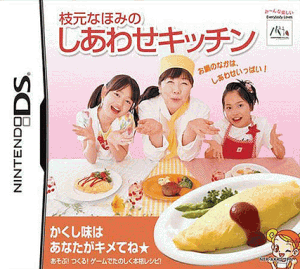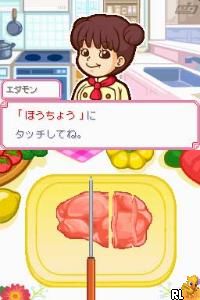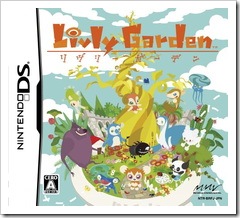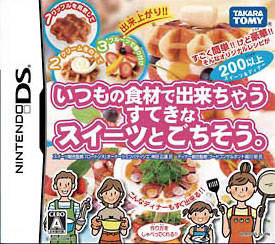 Happy times with Naomi Edamoto’s Happy Kitchen! I’ve been playing this since around the time I got Itsumo no Shokuzai, but I’ve been stretching it out because I didn’t want it to end! This falls under Category 2 of children’s games: children’s games even adults can enjoy.
Happy times with Naomi Edamoto’s Happy Kitchen! I’ve been playing this since around the time I got Itsumo no Shokuzai, but I’ve been stretching it out because I didn’t want it to end! This falls under Category 2 of children’s games: children’s games even adults can enjoy.
Edamoto Naomi no Shiawase Kitchen is a kid’s game about a little girl named Tsugumi who promises to make a home-cooked meal for her dad. The only problem is, she doesn’t know how to cook! So, since it’s a kid’s game, instead of asking her mom to teach her like an ordinary person would, Tsugumi wishes on a star and the Fairy Queen on the Moon (uh-huh) sends down an angel to help her. This angel possesses and animates Tsugumi’s stuffed bunny Usako, and their adventures begin.
Oh, and also famous Japanese chef Naomi Edamoto (never heard of her) suddenly shows up to teach Tsugumi how to cook in fourteen lessons. Magic is a wonderful thing.
I got it because it was a cooking game, but I rapidly found myself more interested in the cute little adventures of Tsugumi and her animated dolls than in the actual cooking. Tsugumi’s so cute. I think they got her characterization just right, making her interesting and lively but not annoying. On one hand she’s sweet, helpful and hardworking, but on the other hand she can also be rash and hyper with just the tiniest hint of a mean streak (Tsugumi+Emily=win). The fact that she wasn’t Little Miss Perfect made me want to cheer her on all the more. Her cast of dolls was interesting as well, in a childish sort of way. I could have interacted with them more by choosing to stay home instead of taking walks in the park every day. Stuff for a second playthrough? I’ll think about it. Seriously.
The cooking itself is a series of chopping and stirring mini-games using the stylus. Chop up the onions, stir fry them in oil, add water, stir the soup, wash and boil rice, all using the stylus. The actions are repetitive, but the meals usually look and sound delicious. I made spaghetti neapolitan (a scrumptious-looking Japanese concoction of spaghetti stir-fried with ketchup, bacon and vegetables), minestrone and rolled cabbage for the final day, which earned me top marks as usual. If you just follow Edamoto’s instructions and then add lots of decorations to your meal at the end you shouldn’t fail.
 Shiawase Kitchen is more of a cooking simulation than a proper cooking game, so for one thing none of the recipes come with quantities listed. Edamoto also skips a lot of steps, e.g. “Let’s make gyoza, I already made the dough”. Most likely the intention is for children to cook together with an adult, so they don’t see the need to be too specific. A pity really, some of those dishes looked great.
Shiawase Kitchen is more of a cooking simulation than a proper cooking game, so for one thing none of the recipes come with quantities listed. Edamoto also skips a lot of steps, e.g. “Let’s make gyoza, I already made the dough”. Most likely the intention is for children to cook together with an adult, so they don’t see the need to be too specific. A pity really, some of those dishes looked great.
I never thought when I picked this up that I’d be that sad when the final day rolled around. :’-< Still, when all’s said and done, it’s very much a children’s game. And it’s in Japanese. And I haven’t played Cooking Mama, but it’s most likely more of the same. I loved it, but I can only recommend it to one group of Western gamers: beginners in Japanese. Since it was developed for Japanese children, it uses mainly kana with only a little kanji, which comes with furigana. Now the problem with kana-only text is that it’s usually hard for beginners to tell where one word ends and the other begins. Never fear, the writers were kind enough to leave spaces between words and phrases. It’s not exact, but it’s more than enough to be able to make sense of just about everything.
Plus they’re kind enough to highlight important nouns in red. Knife will be ほうちょう and will frequently have an arrow pointing to it, etc. If you didn’t know that pot was ‘nabe’ and rice cooker was ‘suihanki’ before you played it, you will by the time you’re done. If you’re learning Japanese and starting to wonder “When will I ever be good enough to play games in Japanese?!” you should give it a shot.
Come to think of it, I never did play games in Japanese when I was learning. That’s because I didn’t learn Japanese to play games with. I just liked the look of the characters and thought it sounded intriguing, so I learned a little here, a little there, took a few classes eventually and went on my merry way. I used Japanese mainly to read books and manga and watch the occasional anime and played all my games in English. Then one day after finishing Atelier Iris 1, 2 and 3, I found I really, really wanted more Atelier stuff. Gee, too bad they’re only in Japaneeee— waitaminnit! And the rest is history.
Enough about that. I’m slowly working my way back into Saigo no Monogatari no Yakusoku, I’m almost done with Rizumi‘s route in TM4, I’ve started TWEWY for real and I finally got some carrot seeds in Shepherd’s Crossing, so I’ll talk about one of those next time.



